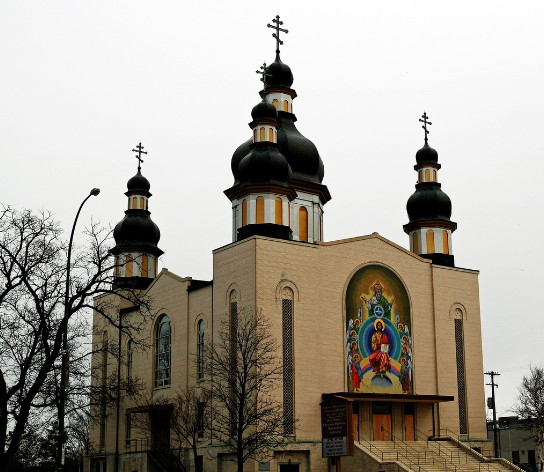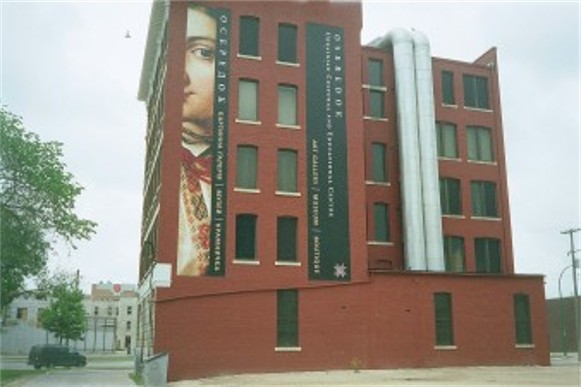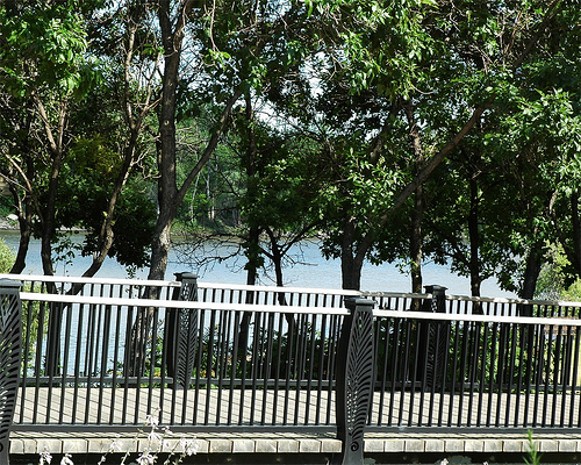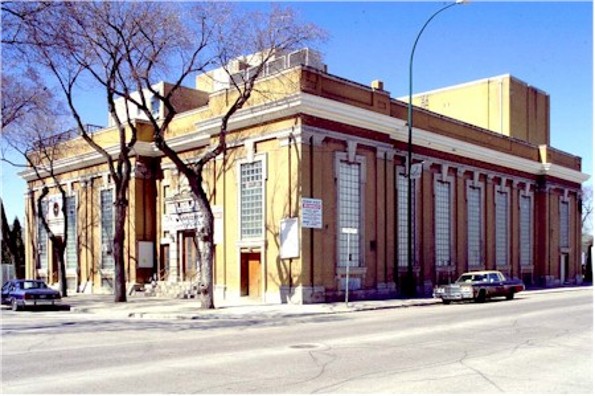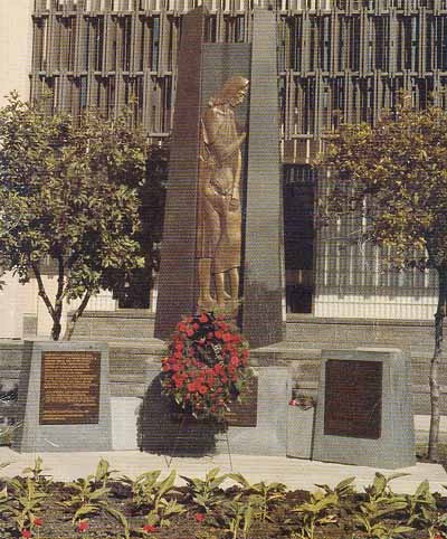Winnipeg
Winnipeg (Вінніпеґ). The capital of and the largest city (2006 pop 694,668) in Manitoba, situated at the confluence of the Red River and Assiniboine River. After the Canadian Pacific Railway (CPR) reached the city in 1885, it became the central railway and immigration dispersal point through which European immigrants passed en route to settling in western Canada. Winnipeg quickly emerged as the largest center of urban Ukrainian population in Canada. Prior to the Second World War its Ukrainian population was several times that of any other Canadian city and it had the largest urban concentration of Ukrainians in Canada until the 1970s.
The nucleus of Winnipeg's Ukrainian community consisted of ten families from the village of Nebyliv, Kalush county, Galicia, who arrived in 1892–3. After 1896, the city's Ukrainian population, made up overwhelmingly of immigrants from Galicia and Bukovyna, grew steadily as some prospective homesteaders decided to stay in Winnipeg. It increased rapidly after 1905 when the boom in Canadian railway construction, mining, and lumbering attracted large numbers of Ukrainian laborers to the city's railway yards and shops, factories, and road and sewer construction projects. By 1914, it was estimated that up to 15,000 Ukrainians, many of them seasonally unemployed migrant laborers, wintered in Winnipeg. Official census data, which did not reflect Ukrainian population figures accurately prior to 1931, indicate that the city's permanent Ukrainian population grew from 3,600 in 1911 to 7,000 in 1921; 21,459 in 1931; 28,162 in 1941; 41,997 in 1951; 53,918 in 1961; 64,305 in 1971; 79,350 in 1981; 98,330 in 1991; and 102,635 in 2001. In 2006 Winnipeg had a Ukrainian population of 110,335, of which 30,090 was of single (Ukrainian only) origin and 80,240 of multiple (Ukrainian and other) origin. In 2001, only 3,510 Winnipegers reported Ukraine as their place of birth, although their numbers have been growing with the arrival of 1,510 immigrants from Ukraine in the city between 1991 and 2006. In 2006, a total of 2,275 people claimed Ukrainian home language use; in 2001, there were 15,315 people with a Ukrainian mother tongue.
Six Ukrainian residential enclaves emerged in Winnipeg by 1914. The oldest, north Point Douglas, was adjacent to the CPR station and major food processing and iron works shops. The largest and most important was in the North End, the immigrant district that extended north from the CPR yards to Inkster Boulevard. Here most of the city's Jews, Germans, Poles and Ukrainians resided and their institutions were located. A third emerged in the Brooklands near the CPR shops at the city's northwestern periphery. A fourth appeared in Elmwood and East Kildonan, on the east side of the Red River opposite the North End. The fifth was in Transcona at the city's northeastern periphery, where Ukrainians who worked in the Canadian Northern Railway (CNoR) shops began to settle in 1912. The sixth and smallest enclave, in Fort Rouge near the CNoR yards, was the only one located south of the city center. Since the 1950s many Ukrainians have left these enclaves and dispersed all across the Winnipeg CMA. Between 1951 and 1981 the proportion of Winnipeg's Ukrainians residing in the old North End fell from 50 to 17 percent. Nevertheless, Ukrainians have retained a preference for the city's northern suburbs (West Kildonan, Garden City, Old Kildonan and The Maples, all north of the old North End and west of the Red River, and East Kildonan and North Kildonan, north of Elmwood and Transcona on the east side of the Red River). Although baby-boomers and young professionals have been moving into South Winnipeg (primarily St. Vital and Fort Garry), Ukrainians still remain underrepresented in the city's wealthiest suburbs south of the Assiniboine River (Tuxedo, River Heights, Charleswood).
The occupational structure of Winnipeg's Ukrainian population has changed over the years. Initially most Ukrainian men found employment on street, sidewalk, sewer and street railway construction crews; in railway yards and repair shops; in iron works shops; and in meat-packing plants. Women worked in restaurants, hotels and garment factories. A small number of Ukrainian-owned businesses—boarding houses, groceries, meat markets, restaurants, pool halls, steamship ticket agencies, shoe repair and tailor shops—also appeared between 1900 and 1920. During the period 1920–60 Ukrainians made significant advances in retail and hardware trade, the service industry, manufacturing, transportation and the professions. In the 1930s Ukrainians (John Coval, Fred Sicinski) established Western Auto and Truck Body Works Ltd (subsequently Flyer Industries) and Fort Garry Motor Body and Paint Works Ltd (subsequently Motor Coach Industries), which evolved into leading North American bus manufacturing companies under new management. After the Second World War Ukrainians owned the Sprague Lumber Company (John Shanski); established the Border Chemical and Border Fertlizer Companies (Mark and Philip Smerchanski) and Central Products and Food Ltd (Stephen Jankowsky); and made significant strides in the hospitality industry, establishing Naleway Caterers (1948) and Alycia's restaurant (1977). At present, Canad Inns, Manitoba's largest hotel chain, is owned and operated by Leo Ledohowski. The first Ukrainian graduated from the University of Manitoba in 1913 and the city's first Ukrainian professionals opened offices during and immediately after the First World War, although their numbers remained insignificant until the 1950s. During the late 1960s, when Ukrainians constituted 11.5 percent of the city's population, they were still underrepresented in the medical (3.3 percent), engineering (5 percent), legal (6.4 percent) and dental (8.5 percent) professions. By the 1990s, they had achieved parity with the general population.
Winnipeg has been the institutional center of Ukrainian church life in Canada for almost a century. It has been the seat of the Ukrainian Catholic Bishop (1912–51), Archbishop (1951–56) and Archbishop-Metropolitan (1956–present) of Canada, and it has been the home of the Consistory (1920–present) and the Archbishop-Metropolitan (1947–present) of the Ukrainian Orthodox Church of Canada.
Ukrainian Catholics, who made up more than half of the city's Ukrainian population well into the 1950s, established eight parishes between 1899 and 1940 including three in the North End and one in each of the other five enclaves. The oldest and largest, Saint Nicholas (1899) and SS Vladimir and Olga (1907), faced each other on the corner of McGregor and Stella in the North End for more than 60 years. Today there are 15 Ukrainian Catholic churches in the city. Since 1913 SS Vladimir and Olga has been the cathedral of the Ukrainian Catholic primate in Canada (Nykyta Budka, Vasyl Ladyka, Maksym Hermaniuk, Michael Bzdel). The current Archbishop-Metropolitan and primate is the Most Rev. Lawrence Huculak (OSBM), appointed in 2006. Three monastic communities—the Sisters Servants of Mary Immaculate (SSMI), the Basilian Fathers (OSBM), and the Redemptorist Fathers (CSSR)— have been active in the city, the first two since 1902, the third since 1956. The Sisters Servants established Saint Nicholas School (1905; renamed Immaculate Heart of Mary School in 1963), a day school that continues to offer a provincially-approved curriculum as well as instruction in the Catholic faith and Ukrainian language. They have also owned and operated the Holy Family Nursing Home, an accredited seniors' facility open to residents of different ethnic and religious backgrounds, since 1956. In 2001 there were almost 19,000 Ukrainian Catholics in the city (about 30 percent fewer than in 1971). The Ukrainian Catholic Brotherhood of Canada (UCB), the Ukrainian Catholic Women's League of Canada (UCWL) and the Ukrainian Catholic Youth (UCY) have had branches in Winnipeg since the mid-1930s, although in recent years the most active lay organizations have been the city's three Ukrainian Catholic Knights of Columbus councils. Since 1959 the archeparchy of Winnipeg has published the weekly newspaper Postup (Winnipeg) (Progress).
Winnipeg's first Ukrainian Orthodox congregation, Saint Mary the Protectress, was established in the North End in 1924 (corner of Burrows and Sinclair). Today there are six churches, including Holy Trinity (corner of Main and Mountain), which has been the cathedral of Ukrainian Orthodox primates in Canada (Mstyslav Skrypnyk, Ivan Ohiienko [Ilarion], Mykhail Khoroshy, Andrei Metiuk, Wasyl Fedak) since the late 1940s. The current Metropolitan is His Beatitude John Stinka, appointed in 2005. In 2001 there were almost 3,000 Ukrainian Orthodox faithful in the city (about 60 percent fewer than in 1971). Since 1932 the church has operated a Ukrainian Orthodox Seminary in Winnipeg. In 1946 it established Saint Andrew's College, which houses the theological seminary, maintains a library and student residence, and has been affiliated with the University of Manitoba since 1962. The church's official organ, Visnyk (Winnipeg) (The Herald), has been published since 1924. Branches of the major pro-Ukrainian Orthodox lay associations— the Ukrainian Self-Reliance League (USRL), the Ukrainian Women's Association of Canada (UWAC), and the Canadian Ukrainian Youth Association ‘SUMK’— have been active in Winnipeg since the 1920s. Ukraïns’kyi holos (Ukrainian Voice), a weekly established in 1910, has supported the church and its lay organizations since 1918.
In 1904 Ukrainians also established the Russian Orthodox Holy Trinity Sobor (corner of MacKenzie and Manitoba), which they attended for several decades. A Ukrainian United Church congregation that traced its origins to the short-lived Independent Greek Church (under Presbyterian auspices 1903–13) existed from 1925 until 1961. A small Ukrainian Evangelical Baptist congregation survives in the North End.
The first secular society in the city was the Shevchenko Reading Association (1899), established by young populists and radicals. In 1906 the association split into socialist and nationalist wings. The socialists organized Ukrainian branches of the Social Democratic Party of Canada in the North End, Elmwood and Transcona (1907, 1911, 1914). When the SDPC was banned during the Red Scare of 1918, they established the Ukrainian Labour Temple (1919) that ultimately became the cornerstone of the Canada-wide pro-Communist Ukrainian Labour-Farmer Temple Association (ULFTA) and its successor the Association of United Ukrainian Canadians (AUUC). Both associations were very active between 1920 and 1950. The AUUC still maintains a presence in its imposing North End headquarters (corner of McGregor and Pritchard), a Manitoba provincial heritage (1995) and Canadian national historic (2009) site. The nationalists organized several cultural-educational societies that merged into the Ukrainian National Home Association (1912; corner of McGregor and Burrows), which flourished until the 1980s but has been relatively inactive since. The Ukrainian Reading Association ‘Prosvita’ (1905; corner of Flora and Mackenzie) and the Canadian-Ukrainian Institute Prosvita (1916; corner of Pritchard and Arlington), both established by Catholic laymen in the North End, flourished until the 1990s. The Taras Shevchenko Reading Club (1914) in the Brooklands, and the Markiian Shashkevych Association (1925) in Point Douglas, expired during the 1960s. Politicized interwar and postwar immigrants established branches of the monarchist Canadian Sitch Association (1924; renamed United Hetman Organization in 1934), which remained active until the 1970s; the militantly nationalist Ukrainian War Veterans’ Association of Canada (UWVA; 1928) and its offspring the Ukrainian National Federation (UNF), the Ukrainian Women's Organization of Canada (UWOC), and the Ukrainian National Youth Federation (UNYF), which were established after 1932 and remained active until the 1990s; the Ukrainian Cultural and Educational Center (Oseredok; 1944), which houses an archive, museum, library, art gallery and boutique and remains very active to the present day; the Ukrainian Free Academy of Sciences in Canada (1949); the Plast Ukrainian Youth Association (1948), modelled on the scouting movement and still active; and the Canadian League for Ukraine's Liberation (1949; renamed League of Ukrainian Canadians after 1991) and its Ukrainian Youth Association ‘SUM’, which are also still active. Other organizations (in 2008) include the Ukrainian Canadian Social Services of Manitoba, the Alpha Omega Women's Alumnae, and the recently reinvigorated Ukrainian Canadian Students’ Union (SUSK) branch. Winnipeg has been the national headquarters of the Ukrainian Canadian Congress (formerly Committee), an umbrella organization that seeks to coordinate the activity of most nationalist and church organizations, since 1940. The Ukrainian Canadian Foundation of Taras Shevchenko has also been headquartered in the city since its inception in 1962.
A number of financial and co-operative institutions have flourished in the city. Ukrainian Catholics established the Ukrainian Mutual Benefit Association of Saint Nicholas (1905), which continues to provide fraternal, financial and insurance services and makes charitable donations to many Catholic and secular organizations. The Workers’ Benevolent Association (WBA; 1922), established by ULFTA members to provide rudimentary health insurance and death benefits, declined during the 1960s and expired at the end of 2004. The People's Co-operative (1928), initially set up as a ULFTA venture, provided consumers with fuel, lumber and dairy products while employing over 150 people in its heyday before it expired in 1992. The small Kalyna Co-operative (1930), established by the UWVA, survives by focusing on the sale of Ukrainian books, records, videos and stationary. Of the ten Ukrainian credit unions established between 1940 and 1966 only two very strong and stable institutions—Carpathia Credit Union (1940) and the North Winnipeg Credit Union (1943)—survive. The Ukrainian Professional and Business Club (1943) provides financial support for community projects and organizations, most recently by working with non-profit groups to send medical supplies to Ukraine.
Winnipeg's Ukrainians have been actively involved in politics on all three levels. At the municipal level the first Ukrainian city councillor was Theodore Stefanyk (aka Stefanik, 1912–13). During the Winnipeg General Strike (1919) police raided the Ukrainian Labour Temple and on ‘Bloody Saturday’ they shot and killed an innocent Ukrainian bystander on Main Street even though there were no Ukrainians among the strike leaders. Ukrainian leftists helped to make William Kolisnyk the first democratically elected Communist to hold public office in North America (1926–30) and they consistently helped to elect representatives of the Communist Party of Canada to city council and the school board (Andrew Bileski, Mary Kardash) until the 1980s. Moderates and conservatives (Taras Ferley, 1932–3; Demetrius Dmytro Elcheshen, 1937–8; William Wasyl Scraba, 1942–5) also sat on city council and the school board (Mary Dyma, 1932–5). The number of Ukrainians elected to city council and the school board increased significantly during the post war years, with four or more councillors elected several times during the 1970s. Most prominent were businessman Stephen Juba, the city's first non-Anglo-Saxon mayor (1956–77), who twinned Winnipeg with Lviv (1973), and conservative councillor Slaw Rebchuk (1949–77), who served as acting mayor on several occasions. In recent years the most prominent Ukrainian on city council has been Harry Lazarenko (1974–7, 1983–2010).
Provincially, Ukrainian Communists (1922) and Independents (1932, 1936) failed to win seats in the legislature until 1941 when Communist (Labour Progressive) William Kardash and Independent Stephen Krawchyk were elected. Kardash, who represented Winnipeg North until 1958, served as provincial party leader and was the only Ukrainian Communist elected to the legislature. Between 1941 and 1969 two or three Ukrainians represented city ridings in each provincial legislature. Since 1969 they have represented three or four city ridings. Traditionally the city's Ukrainian-Canadian voters have supported the Co-operative Commonwealth Federation/New Democratic Party, which has monopolized seats in the city's northern districts and suburbs. Of the more than 50 provincial contests won in Winnipeg by candidates of Ukrainian origin (1941–2007), at least two-thirds have gone to the CCF/NDP. Long-serving MLAs include John Hawryluk (CCF, Burrows, 1949–62), Steve Patrick (Liberal, Assiniboia, 1962–77), Ben Hanuschak (NDP, Burrows, 1966–81), Wilson Parasiuk (NDP, Transcona, 1977–88), Jim Maloway (NDP, Elmwood, 1986–2008) and Dave Chomiak (NDP, Kildonan, 1990–present) who has served as Minister of Health (1999–2004), Energy, Science and Technology (2004–06), and Justice. Gary Filmon (Conservative, Tuxedo, 1979–2000), Manitoba's premier in 1988–99, was of Polish-Ukrainian ancestry. Peter Liba served as lieutenant-governor of Manitoba (1999–2004).
Winnipeg's Ukrainians have had much less success securing federal nominations and winning seats in parliament. Prior to 1953 only two Independents (1923, 1949) ran with little success and when a Ukrainian secured the Progressive Conservative nomination in Winnipeg North that year he finished a very distant third behind the CCF incumbent. Between 1962 and 1984 Liberals and PCs repeatedly nominated prominent Ukrainian community leaders in North Winnipeg but failed to dislodge the NDP. Judy Wasylycia-Leis (NDP) became the first politician of (mixed-) Ukrainian origin to win a federal seat in Winnipeg when she was elected in Winnipeg North Center in 1997, and subsequently re-elected there (2000) and in Winnipeg North (2004, 2006, 2008) until she resigned from her seat in 2010. Jim Maloway (NDP, Elmwood-Transcona) was elected in 2008. Winnipeg residents William Wall (Volokhatiuk) (Liberal, 1955–62) and Paul Yuzyk (Conservative, 1963–86) were appointed to the Senate of Canada.
The performing arts have a rich tradition in Winnipeg. By 1910 plays, operettas and concerts were a staple of Ukrainian community life. Before, during and after the First World War the nationalist Mariia Zankovetska, Boian, and Ivan Kotliarevsky Choirs and Drama Circles, and the socialist Volodymyr Vynnychenko Drama Society, put on countless plays and recitals. During the interwar years, conductor and composer Yevhen Turula organized highly regarded choirs and staged operettas at the Institute Prosvita and the Ukrainian National Home; ULFTA mandolin orchestras toured Canada; and immigrant playwrights including the ULFTA's writer-in-residence Myroslav Irchan, the populists Dmytro Hunkevych (Hunkewich) and Semen Kovbel (Kowbel), and the nationalists Oleksander Luhovy and Pylyp Ostapchuk wrote plays performed all across Canada. In the 1960s Yaroslaw Semchyshyn (commonly know as Cecil) established a Ukrainian Theatre, which put on several plays and operettas. Ukrainian folk dancing became a popular recreational and stage activity after Vasyl Avramenko visited Winnipeg in 1926–7 and 1937–8 and trained a cadre of instructors, including Peter Hladun who established Rusalka, the city's premier folk dance ensemble, at the UNF hall in 1962. Noteworthy new dance ensembles include Orlan and Rozmai. From 1941 until his death in 1944 Oleksander Koshyts (Alexander Koshetz), who had visited Winnipeg with the Ukrainian National Choir in 1923 and 1926, spent the summer months in the city teaching music and choral conducting at courses sponsored by the UNF. Musicologist Dr. Pavlo Matsenko (Paul Macenko) and noted pianist and teacher John Melnyk assisted Koshyts; Walter Klymkiw, who became conductor of Winnipeg's UNYF Choir (1951) and the Oleksander Koshetz Choir (1967), was one of his students. Today, in addition to the Koshetz Choir, Winnipeg has two major choral groups: Hoosli (1969), a male chorus organized by alumni of Saint Vladimir's Ukrainian Catholic minor seminary, and the Melos Folk Ensemble (2005), which combines mixed chorus, orchestra and dancers.
Since the 1930s many Winnipegers of Ukrainian and mixed Ukrainian heritage have achieved prominence in the performing arts. They include classical violinists John Kuchmy, Taras Hubicky, Bohdan Hubicky (d 1940) and Donna Grescoe, who played with major British and American symphony orchestras or pursued solo careers (1930s–1970s); minimalist composer and pianist Lubomyr Melnyk; band singer and 1960s Canadian TV icon Juliette (Sysak-Cavazzi); Ukrainian-Canadian ‘country’ singers Mickey and Bunny (Modest Sklepowich and Orissia Ewanchuk); Broadway and TV singer/actor Ed Evanko and singer/dancer Jeremy Kushnier; stage, TV and film actors Peter Boretski, Paul Maxwell (Popovich), Marilyn (Mimi) Kuzyk and Tamara Gorski; musical theater composer Danny Schur; eclectic Ukrainian folksinger Alexis Kochan; arthouse film producer Greg Klymkiw; documentary filmmaker John Paskievich; rock and roll legend Randy Bachman (German father/Ukrainian mother); and pop singer and composer Chantal Kreviazuk (Métis maternal great-grandmother).
Among the prominent Ukrainian-Canadian artists who have lived and worked in Winnipeg are pioneer cartoonist and humourist Yakiv Maidanyk (Jacob Maydanyk); painter, illustrator and Winnipeg Free Press editorial cartoonist Peter Kuch; painter William Kurelek, who spent his youth and adolescence in the city; painter, sculptor and ceramic artist Roman Kowal; painter, printmaker and sculptor Don Proch; painter and printmaker William Lobchuk; and popular sculptor Leonid Molodozhanyn (Leo Mol). The Leo Mol Sculpture Garden (1992) in Assiniboine Park features over 300 works bequeathed to the city by the artist.
Winnipeg-born Ukrainian Canadians have also achieved success in athletics. The Canadian Ukrainian Athletic Club (CUAC; 1925), and the Institute Prosvita Athletic Club (IPAC; 1932), sponsored men's and women's baseball, softball, basketball, hockey and soccer teams in various age categories until the 1990s. CUAC, which had its own athletic grounds (corner Church and Arlington), produced many local, provincial and national championship teams, especially in Senior Girl's Softball, and at least two of its alumna had all-star careers in the All-American Girls Professional Baseball League (1940s–1950s). IPAC fielded strong senior men's basketball teams during the early 1960s and placed several players on the Canadian national team. Ukrainian athletes began to enter professional sports during the 1920s. Prominent National Hockey League (NHL) players have included Nick Wasnie, Alex Shibicky, Joe Cooper (Krupiak), Bill Ezinicki, Bill Juzda, Wally Stanowski, CUAC alumnus Nick Mickoski, NHL Hall-of-Famers Billy Mosienko (see William Mosienko) and Terry Sawchuk, Bob Woytowich, Dave Semenko and James Patrick. CUAC alumnus Vic Zamick was a perennial scoring champion and Hall-of-Famer in the English Hockey League (1940s–1950s). Canadian Football League players include Bud Korchak, Steve Patrick and Gene Lakusiak. Orest Meleschuk (1972), Cathy and Chris Pidzarko (1984), and Kerry Burtnyk (1995) have won men's and women's World curling championships.
Until the 1950s Winnipeg was the most important Ukrainian publishing and media center in Canada. Scores of weekly newspapers, tabloids, and magazines reflecting the religious, political and ideological diversity within the Ukrainian-Canadian community were edited and published in the city. The most important newspapers included Kanadiis’kyi farmer (1903–81), the first Ukrainian newspaper in Canada; the Protestant Ranok (Winnipeg) (later Kanadiis’kyi ranok) (1905–61); the socialist Chervonyi prapor (Winnipeg) (1907–8) followed by Robochyi narod (1909–18); the populist Ukraïns’kyi holos (1910–present); the Catholic Kanadiis’kyi rusyn / Kanadiis’kyi ukraïnets’ (1911–31); the pro-Communist Ukraïns’ki robitnychi visty (1919–37), Narodna hazeta (Winnipeg) (1937–40) and Ukraïns’ke slovo (Winnipeg) (1943–65); and the nationalist Novyi shliakh (1942–76). Today only Ukraïns’kyi holos, the Catholic Postup (Winnipeg) and the Orthodox Visnyk (Winnipeg) remain. A number of Ukrainian radio programs, including the “Voice of Ukraine” hosted by Fr. Semen Izhyk on radio station CFRY, were broadcast during the 1950s and 1960s. Since 1975 regular Ukrainian programs have been broadcast six days a week on Winnipeg's ethnic radio station CKJS.
Private Ukrainian language and heritage classes have been available in Winnipeg for almost a century. The Adam Kotsko student residence (1915–17), the Metropolitan Andrei Sheptytsky residence (1916–23), and the Winnipeg branch of the Mohyla Ukrainian Institute (1927–34) offered instruction in Ukrainian history and literature in addition to providing room and board. During the interwar years many parishes and cultural-educational societies, including the ULFTA, sponsored evening or weekend Ukrainian classes for children. In 1938 almost 1,000 pupils attended classes in 14 institutions. By 1967 the number had climbed to 1,500 pupils. At present, only one parish and one secular society offer elementary instruction to a dwindling number of children. Private Ukrainian language instruction has been replaced by publicly funded education. In 1962 the Ukrainian language became an elective subject in several city high schools and in 1967 it became a fully accredited university entrance course. Since 1979 an English-Ukrainian bilingual program has been available to public school students from Kindergarten to Grade VIII. Enrollment peaked at 1,000 during the 1980s and has remained steady at 600–700 in recent years. The program is offered in six city public schools. The Manitoba Parents for Ukrainian Education (MPUE; 1979) work to promote, enhance and expand the program. The Osvita Foundation provides funding and financial support to the MPUE. The University of Manitoba has offered courses in Ukrainian language and literature since 1949, when a department of Slavic studies created and first headed by Jaroslav Rudnyckyj, who subsequently served on the Royal Commission on Bilingualism and Bilculturalism (1963–71). The Centre for Ukrainian Canadian Studies (1981) at that university coordinates the teaching of courses relevant to Ukrainian and Ukrainian-Canadian studies offered by several departments while the Archives of the Ukrainian Canadian Experience (2003) help to preserve and interpret the community's history.
Several markers and monuments have been erected by Ukrainians in the city during the past century. They include small monuments commemorating 50 years of Ukrainian settlement in Canada (1941), Ukrainians in the Canadian Armed Forces (1942), and the Ukrainian Catholic poet Markiian Shashkevych (1944), all in the Shashkevych Park adjacent to Saint Andrew's Ukrainian Catholic church on Euclid Avenue in north Point Douglas; a bust of the poet Ivan Franko beside the Ivan Franko Seniors' Manor adjacent to the Ukrainian Labour Temple in the North End; a small statue of Volodymyr the Great at the entrance to the parking lot adjacent to SS Vladimir and Olga Ukrainian Catholic cathedral; and a small marker commemorating the poet Taras Shevchenko in a tiny green space opposite the Ukrainian National Home. The two major Ukrainian public monuments in Winnipeg are the Taras Shevchenko statue (1961) on the grounds of the Manitoba Legislative Building, and a monument in front of Winnipeg City Hall commemorating victims of the Famine-Genocide of 1932–3 in Soviet Ukraine (1983). The Leo Mol Sculpture Garden also contains statues of prominent Ukrainians, including Taras Shevchenko.
Major annual community events include Ukrainian New Year's Eve dances (Malanka); observances of the Famine-Genocide of 1932–3 (ie, the Holodomor); Folklorama, Winnipeg's annual multi-ethnic summer cultural festival; and the triennial conventions of the Ukrainian Canadian Congress.
Orest Martynowych
[This article was written in 2010.]
